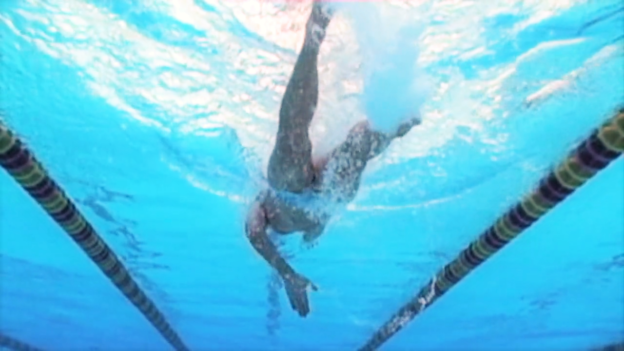Getting the Freestyle Kick right
Acquiring the capability to kick freestyle fast requires that a swimmer develop three crucial abilities:
- Extraordinary ankle plantar flexion
- Leg and core strength for the hip flexors, hip extenders, and knee extenders with the correct biomechanics
- Tremendous stamina to sustain very fast leg motions for an extended period
(Although having big feet is an advantage, it is not an essential requirement of fast kicking.)
This week in our Race Club video release, we feature a new competitive swimmer, Marc Clayton, who is trying to conquer the art of kicking fast. Like many new swimmers, Marc has poor ankle plantar flexibility. To compensate for his lack of ankle flexibility, Marc utilizes a huge knee bend on every third down kick, trying to gain more propulsion in that way.
Bending the knees is essential to get the propulsion needed during the down kick in freestyle. Over-bending the knees leads to tremendous deceleration or slowing down before the down kick. The slowing from the excessive knee bend is not compensated enough by the acceleration from the ensuing hard down kick. The considerable variation in speed from slow to fast caused by the knee bend does not take advantage of the law of inertia. Overbending the knees in freestyle or dolphin kick leads to a slower, inefficient kick.
The ideal knee bend in freestyle and dolphin kick ranges from around 55-75 degrees. Bending the knee less than 55 degrees does not enable the swimmer to generate enough propulsion on the down kick. Bending the knees more than 75 degrees seems to do more harm than good. On the surface, less harm (less drag with the foot in the air) is caused by the knee bend than occurs underwater. Although some swimmers can reduce the drag caused by bending the knees in dolphin kick by dropping the upper leg deeper in the water (flexing at the hip) prior the down kick, in freestyle kick, we have found (using velocity meter technology) that bending the knees past 65-75 degrees is generally not a good technique.
A fast kick begins with developing great plantar flexibility in the ankles. To improve ankle plantar flexibility is not as challenging as one would think. In fact, with a few key stretches done daily, which we will feature in an upcoming video, the plantar flexibility and inversion (pigeon-toeing) of the ankle can improve significantly in a matter of days or weeks.
To prevent the swimmer’s knees’ overbending and improve the kicking mechanics, we employ two important pieces of the equipment- the elastic band (Finis) and the Kick Trainer Cordz (Stretch Cordz). The elastic band is placed around both legs, below the knees, which helps keep the kicking motion tighter. The Kick Trainer is more complicated and requires a few minutes to put on. We always use it with fins on. The Kick Trainer’s elastic cords, attached to the ankles and opposite shoulders above, apply more load to the down kick and help prevent the overbending of the knees. Both tools help us teach the proper kicking biomechanics for freestyle.
Finally, to kick fast, there is no substitute for lots of kicking training in the water. If we ask our legs to contribute a lot to our speed during races, then we need to have the tools to make them generate propulsion- ankle flexibility, leg and core strength, and stamina. Considering that the stroke rate of the legs for a hundred freestyle is roughly 600 kicks per minute, the legs need to be relatively more fit than the arms. Train your kicking legs hard and often. Simultaneously, add the ankle stretches and leg strength work, and you will start to see your kicking times improve dramatically.
Yours in Swimming,
Gary Sr.


What if for some reason a person can never get god ankle plantar flexion (e.g. because of a badly broken leg) – will it still be possible to swim a decent freestyle or is it just to give up? My approach would be to work on the ankle with physio but then really to try to get all other stuff as good as possible to compensate as much as possible from the drag from the ankle but is that just naive to think a stiff ankle can be worked around? Thanks for great articles/insights – all best 🙂
The shorter the freestyle race, the more important role the kick plays in the overall speed of the swimmer. If you are unable to get plantar flexibility, focus on longer races using a higher stroke rate. Anders Holmertz ( a Swede) swam a 1:46 200 m freestyle in the 90’s with a poor kick…but had a 120 stroke rate. Gregorio Paltrinieri won the 1500 m freestyle in the Rio Olympic Games with a 96 SR..and one down kick per stroke cycle. In other words, if you don’t have a fast kick, then you’d better have a fast SR.
Thank you so much Gary
You are welcome!